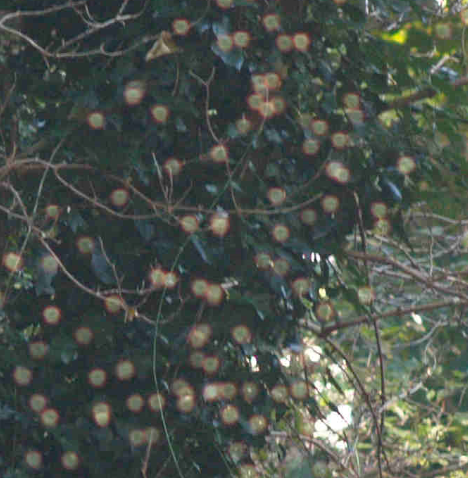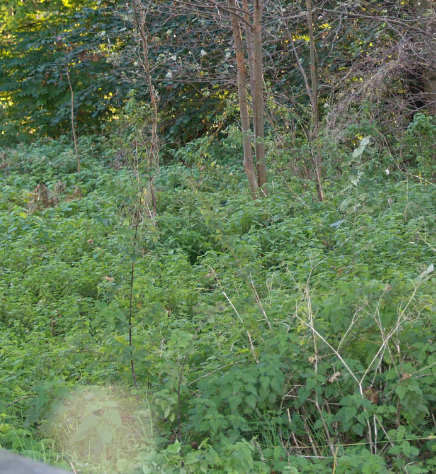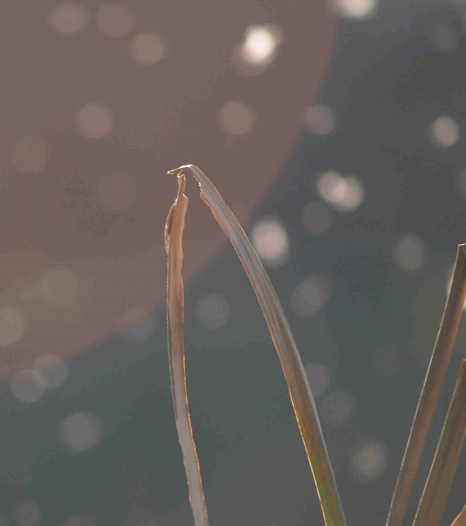Orbs that are not dust

Insect orbs
Dust is the most frequently mentioned cause of orbs. However, any object in the orb zone can give rise to an circle of confusion. One type often mentioned is insects.

A cloud of Midges appear as 'orbs' in this photo which was taken in daylight without flash.In the photo above, a cloud of midges has been transformed into colourful orbs. They are too close to the camera to be in focus (and so in the orb zone) and, being strongly illuminated from behind by a low sun, they show up as orbs.
More typical, perhaps, is the solitary insect orb in the picture below. This picture used flash.

Insect caught as an orb (bottom of pic) in daylight using flash.
Orbs beyond the orb zone
Just as anything too close to a camera is out of focus, objects too far away can be out of focus as well. It is quite unusual for distant objects to be out of focus with digital cameras because of their huge depth of field but it IS possible. It is particularly likely if you are using a zoom lens at high magnification. It is thus possible for distant objects to produce orbs, as well as very close ones, though it is rare.

Seeds float behind rushes and appear as orbs. The huge partial red 'orb' (top left) is flare. The photo was taken in daylight without flash. The scene is backlit by the sun (hence the flare).The conditions you need for long distance orbs are as follows
- daylight or strong artificial light (flash won't do it - it can't reach!)
- distant objects (forming orbs) out of focus
- distant objects (forming orbs) brightly lit
These conditions are satisfied in the photo above which shows rare long distance, daylight orbs. The orbs here are produced by seeds, released by the rushes in the foreground, floating through in the air in the distance.
Such orbs could genuinely be behind objects in the picture (indeed there is an example of this in the pic above - see the topmost rush stalk on the right edge). However, these orbs are still circles of confusion produced by brightly lit floating objects. Such long-distance orbs tend to be less sharp than 'normal' orbs.
Applying science to orbs
The Orb Zone Theory presents a case study of how the scientific method can be applied to paranormal phenomena.
Daylight orbs on video
Daylight orbs, caused by insects, are quite common on video (see here). Not only the usual white/light ones, like this, but even black/dark orbs.
The lone orb
Insects are frequently said to cause orbs but how many do they really cause? For an insect to show up as an orb it needs to be caught by camera flash in the orb zone. The orb zone is very small so it is unlikely you would get more than one insect at any one time forming an orb in a photo (except in the unusual circumstances of the photo top left where midges are flocking). In the photo bottom left (a daylight shot with flash) there was a deliberate attempt to produce an insect orb. Only one insect obliged and other photos taken at the same time showed none at all.
Genuinely paranormal?
Solitary orbs are sometimes seen as 'genuinely paranormal' (since dust orbs are assumed to come in multiples, though this is a questionable assumption). They are often particularly bright and large. It could well be that they are caused by insects rather than dust. They could occur in those situations where the orb zone is too far from the camera to pick up dust. Insects are, of course, much bigger and so may be picked up at a greater distance.
Orbs on night videos (such as infrared) usually move and are often put down to insects. This is because they move quite rapidly (faster than dust). However, if a particle of dust is very near the camera lens, it will appear to move rapidly (in the same way that a nearby car seems to move faster, from left to right, than a distant one).
Infrared video cameras use powerful infrared illumination, capable of producing orbs in the same way as a flash with a still camera. Being infrared, it is invisible to humans so it can be difficult to appreciate just how bright the light source is. While some orbs seen on infrared video may well be insects, most are probably dust, just like still cameras.